2022 Monarch Butterfly Report: A Mystery
News Brief by Kip Hansen – 21 March 2022
The magical marvelous Monarch Butterfly is surging – they are ramping up – populations numbers are skyrocketing! That is to say, according to Monarch censuses, the numbers of migrating Monarchs overwintering in both the Western Migration and the Eastern Migration have vastly improved over last year.
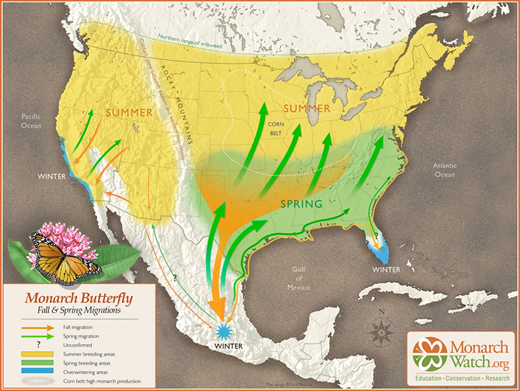
Monarch butterflies (Danaus plexippus) and their annual North American migration represent one of the mysteries of the animal kingdom, with their so-far inexplicable ability to produce one generation each year capable of traveling up to 2,500 miles and then, even after such a long journey for such a small insect, overwintering, without any eating, until Spring, at which time they fly north again eating and mating along the way.
Monarchs feed on flower nectar, like other butterflies, but in order to breed, they require milkweed plants, on which they lay their eggs. Although milkweed is slightly poisonous, monarch caterpillars will only eat milkweed leaves. It is believed that changing agricultural practices to suppress weeds and the widespread mowing of highway verges has greatly reduced the available milkweed for monarchs and contributed to their declining numbers.
And this last winter?
The Western Migration (and see map above) showed a fabulous comeback. According to the Xerces Society, the western migration for the 2021-2022 season was a great success with upwards of 250,000 monarchs found overwintering known sites along the southern California coast from Monterey south to San Luis Obispo. Xerces says this is “an over 100-fold increase from the previous year’s total of less than 2,000 monarchs and the highest total since 2016.”
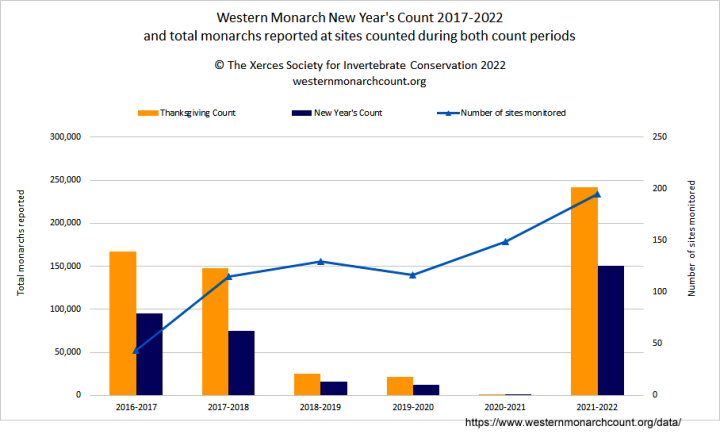
How can this be so? No one is really sure. For any closely watched annual natural phenomena to increase by 100 times in a single year is more than a little unusual.
However, it is not strange at all to those who are familiar with real-world population dynamics. It is possible that the Western Monarch population may be acting like an “island species” in which local abundance or scarcity of sources and intra-species competition control species population size. In these conditions, the mathematical formulas of population dynamics show definite chaotic features, including population crashes and booms (see the graphic of May Island Squirrel Population). The actuality of this type of chaotic behavior has been confirmed in the natural world many times.
Monarchs, however, are capable of living year-around in the southern parts of California and the northern parts of Mexico and are found quite commonly living and breeding at all times of the year. This means that not all the monarch west of the Rockies take part in the annual migration. Many just do what humans often do, they move to southern California for the winter and get on with their normal lives. For monarch, that means mating, laying eggs, dying, and the new generation hatches as caterpillars which eat milkweed and pupate to become new monarchs. Tagging efforts have shown that some few Western Monarchs may even migrate to the same sites in Central Mexico as the Eastern Monarchs.
Extinction fears for the Western Monarch are not about a real extinction of Monarch butterflies west of the Rocky Mountains, but rather the fear that the Western Monarch Migration will cease to exist: “…in 1983, the IUCN took the unprecedented step of creating a new category in the Invertebrate Red Data Book, in order to list the monarch migration as a Threatened Phenomenon. This is because the numbers of American migrants are falling sharply. Figures for 1997-2016 show a 74 percent decline in California’s overwintering monarchs.” And last year, the numbers for the western migration were vanishing small….almost nonexistent.
Possibly contributing to the increase has been quite a bit of citizen-group action in the West to plant milkweed both in home gardens and on public lands and to discourage the mowing of roadway verges there. This type of action is popular in the UK as well.
And the Eastern United States Migration?
Here we run into a dearth of data….because of Covid! The usual data sources: butterfly counts along the migration route north to south were curtailed or abandoned entirely due to (unfounded) fears of being either in groups of humans or even in some cases the fear of being outdoors.
Last November, Monarch watchers east of the Rocky Mountains had mixed opinions on how the season would turn out.
“Karen Oberhauser, founder of monarch butterfly citizen science organization Monarch Joint Venture and professor of restoration ecology at the University of Wisconsin-Madison, said she’s cautiously optimistic about summer breeding activity and anecdotal reports of high numbers seen during the fall migration. “I hope … it translates into good numbers in Mexico,” she said.” [ source ] In the same report, “Chip Taylor, founder of Monarch Watch, was less enthusiastic and suggested that the eastern monarch migration population will decline this year. He pointed out that late migrations historically make for smaller overwintering populations.”
The usual sources of census data for the Eastern Monarch Migration have been silent the last 2 years – figures are usually published in February by Mexico’s CONANP – Comisión National de Áreas Naturales Protegidas. Last year there was not official announcement (that I could find). The Monarch Sanctuaries in Mexico were officially closed to visitors because of Covid. I am not sure how this prevented the rangers and researchers from performing their usual census, but either they did not do so, or it is running late.
The latest population data for the eastern migration is from the winter of 2019-2020:
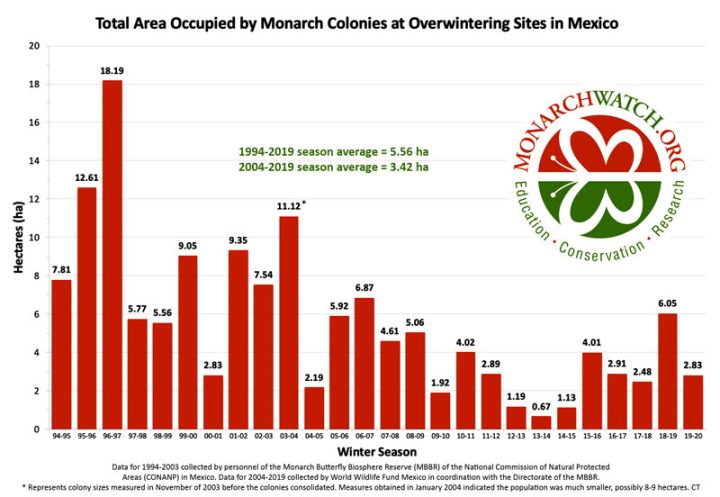
I am attempting to get an official number for the 2020-2021 season – but have had no luck so far. The best I have found is a comment made by Monarch Watch’s Chip Taylor in his post on the 6th January 2022:
“Last year my estimate for the hectare total was almost spot on – 2.0 hectares vs a measured 2.01 hectares. It was more of a guess than a data-based prediction, but I’ll take credit for being close. There are reasons to think I will be close again this year and other reasons to predict that the number will be higher.” (said while predicting another drop in population for 2021-2022).
I have information from local Monarch researchers in Mexico who report that CONANP may release a census soon (it has not as of 20 March 2022).
I can only offer this good news from an eye-witness account:
“But in our estimation, in the Cerro Pelón Sanctuary, there was doubling of the butterflies from last season.” (personal communication — paraphrased for language differences)
Cerro Pelón Santuario (or reserve) is only one of the locations where eastern migrating monarchs roost in huge masses to overwinter. It located in the mountains about 60 miles northeast of Mexico City:
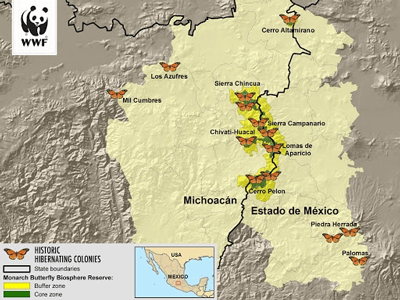
Other major monarch reserves are all located in the same general area. Cerro Pelón is shown in the middle. The major roosts are within the yellow area, with minor roosts scattered around in the buff region shown.
So we have an encouraging but partial and unofficial report from the scene in Mexico, which gives us this general picture:
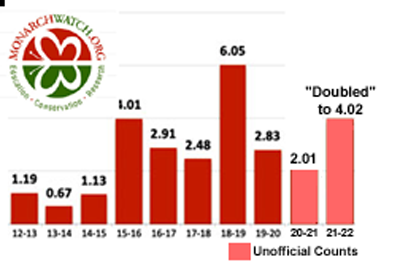
If our unofficial estimate for this year is correct and verified, eastern monarchs are making a slow but steady comeback. When and if CONANP releases an official number, I will make an updated report.
Bottom Line:
The Western Monarch Migration, which just last year was predicted to vanish completely, has pulled a marvelous “rabbit-out-of-a-hat” trick on all the nay-sayers, doom promoters and all-is-lost-ers. Experts and advocates are entirely thrilled and mystified by the 100-fold increase in roosting monarchs in the 2021-2022 winter. Seeming absolutely impossible to some experts, a mere 2,000 surviving migrating monarchs, only a percentage of whom could have been female, apparently managed to breed the population up to 250,000 in a single season (which is composed of several generations).
The Eastern Monarch Migration is shrouded somewhat in the fog created by the Covid pandemic with official census numbers missing and/or unreliable. Opinions from monarch expert in the United States range from optimistic to pessimistic. Partial information from on-the-scene experts at Cerro Pelón gives us hope that things are at least holding steady.
# # # # #
Author’s Comment:
The news from California is intriguing and the confusion of the experts terrifically amusing. I think many of the experts were counting on being able to say “We told you so! Now the western monarch migration is extinct and it is your fault.” [ here and here ]. Early on, with the Thanksgiving Monarch Count in California, things were looking good, but experts were still moaning and denying recovery. I hope to find time to write a longer piece detailing the conservation efforts underway, the speculation on the biologically impossible surge in the population and other fascinating aspects of this larger story.
Our on-site reporter is Joel Moreno Rojas who, with Ellen Sharp, operates the JM Butterfly B&B in Macheros, Mexico, adjacent to the Cerro Pelón reserve. “The business quickly turned Macheros into a popular butterfly tourist destination. …. directly employing more than a dozen people as guides, translators, cooks, servers, drivers and housekeepers in winter, as well as 3-4 construction and maintenance workers year-round”. Maybe next winter, I will go and stay for a week or two.
In the meantime, this spring remember to plant a few native milkweeds in your flower garden. If you belong to a local conservation group, get them to advocate for the state and country road maintenance departments to spare roadside milkweed patches. If you have young children (5-15), search out monarch caterpillars, capture and raise them to maturity and let your kids witness the miracle of the caterpillar-to-butterfly transformation. There are instructions online. Once the butterfly has emerged and the wings are fully dry, release the butterfly onto nectar-producing flowers in your garden. Be aware – it will fly away in a day or so – so make sure your kids know this in advance.
Nature is full of surprises!
Thanks for reading.
This commentary was first published on March 21, 2022 at the wattsupwiththatwebsite.

